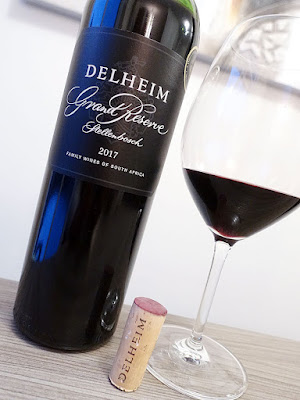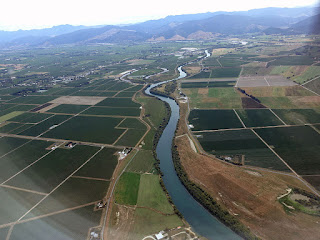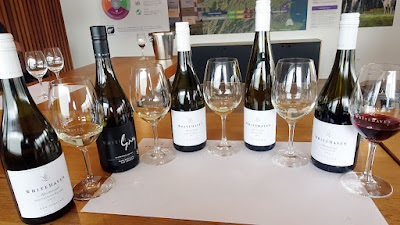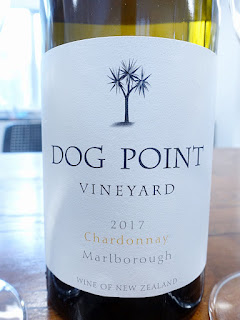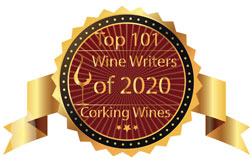red wine review is an excellent Hawke's Bay Syrah that arrived at the LCBO last month as an Online & Flagship Exclusive in the LCBO VINTAGES New Release Collection - with bottles now available at quite a few stores across Ontario.
It is produced by Babich Wines, one of New Zealand's most prominent and oldest family-owned wineries. It was founded in 1916 by Josip Babich, an immigrant from Dalmatia (which is now part of modern day Croatia), who immigrated to NZ at 14 years old in 1910 to join his three brothers and sell Kauri gum in New Zealand's far north. In 1911, the Babich brothers put a deposit on a plot of land in Henderson Valley (West Auckland), which later became the family homestead, winery, and company headquarters. In 1912, Josip planted his first vineyard on a terrace above the Kaikino Swamp gum field, and in 1916 he made his first New Zealand wine and sold it in casks and bottles under the Babich Brothers label.
In 1929, Josip married Mara Grgic, and together they had 5 children over the following years. In 1949, Josip's son, Peter, joins him in the family vineyard. The 1950s brought further expansion of the property in West Auckland, while in 1958, Josip's son, Joseph, joined Babich Wines. Further expansion ensued during the 1960s, with a growing emphasis on table wine production. In 1980, the first Babich wines were exported to Europe, an achievement that is the highlight of Josip's winemaking career.
By 1984, Babich Wines began producing their first wines from the Gimblett Gravels region in Hawke's Bay, and by the end of the decade, they increased their presence in the region by establishing a second 36 hectare vineyard on Gimblett Rd. The family company's success led to more growth and expansion, including several acquisitions and partnerships, and in 2001, David Babich, son of Peter Babich, became the third generation of the family to join the business. In 2013, Babich completed construction of their new winery in Marlborough, while acquiring the 9.7 hectare St. John Vineyard in the Bridge Pa Triangle - where this wine is from. In 2016, Babich Wines celebrated 100 years of innovation, achievement and winemaking excellence, while in 2018, André Babich, son of Joe Babich, joined the family business.
Today, the aim of Babich Wines is to craft sustainable wines that are stylish, refined, and have an easy drinking appeal. To support this, their goal is to have vineyards in the right regions on superior sites, and getting the right varieties on those superior sites. With more than 100 years of winemaking experience across three generations and three outstanding wine regions, wine is the family's life. The Babich family has a long history of looking ahead as they love their craft, love doing things by hand, and caring for the land. Their hard-working spirit still runs deep within their veins, while their vision is to simply share their passion through patience, experience, and good old-fashioned wisdom, as well as leading the style and evolution of sustainably grown and crafted New Zealand wine.
I had the pleasure of first tasting this exact same vintage at their winery in Auckland back in March 2020 when I was visiting New Zealand. It is crafted with 100% Syrah using grapes that were grown in the St. Johns Vineyard, which is located in the Bridge Pa sub-region of Hawke's Bay. This is also a single clone Syrah - using only the 470 clone, a late-ripening clonal variety with open clusters that discourages fungal disease, while producing aromatic, full-bodied wines with high acidity, deep colour, and good tannins structure. The 470 Syrah clone is extremely popular in France and is the most widely-planted in Hermitage. The grapes were machine harvested and de-stemmed in the field from April 2nd to 3rd. The berries were lightly crushed, fermented in stainless steel vats, and also underwent malolactic fermentation. The wine was matured for 8 months in French oak barrels (25% new), and was fined using egg whites, with minimal filtration.
The 2017 growing season in New Zealand was generally cooler than average and dry. However, in Hawke's Bay it was searingly hot at times. In Autumn, there were some heavy rains right before harvest, which disturbed picking and reduced yields. Despite some difficulties, the quality of what was picked is high. After tasting this same, exact wine 4 years ago, let's see how this 2017 Hawke's Bay Syrah is tasting tonight...
Screw cap. From Bridge Pa Triangle, the highly aromatic nose is fragrant and open, offering complex aromas of wet earth, black pepper spice, dark fruit, blackberry, and stony mineral, with hints of mushroom, floral, and meaty notes. The elegant, medium+ bodied palate has lovely dark berry, blackberry, black pepper spice, meaty, savoury wet earth, plum, and cocoa flavours that are supported by fresh, succulent acidity. It's nicely balanced throughout with smooth, fine-grained tannins and good structure. Savoury mineral, earth, and cocoa notes linger on the long finish. A Syrah lover's Syrah to enjoy over the next 5-6 years and a highly recommended buy! Score: 92+ pts
A few lovely Babich Wines can be found at the LCBO, while the entire portfolio can be ordered through their Agent - Dionysus Wines & Spirits.
It is produced by Babich Wines, one of New Zealand's most prominent and oldest family-owned wineries. It was founded in 1916 by Josip Babich, an immigrant from Dalmatia (which is now part of modern day Croatia), who immigrated to NZ at 14 years old in 1910 to join his three brothers and sell Kauri gum in New Zealand's far north. In 1911, the Babich brothers put a deposit on a plot of land in Henderson Valley (West Auckland), which later became the family homestead, winery, and company headquarters. In 1912, Josip planted his first vineyard on a terrace above the Kaikino Swamp gum field, and in 1916 he made his first New Zealand wine and sold it in casks and bottles under the Babich Brothers label.
In 1929, Josip married Mara Grgic, and together they had 5 children over the following years. In 1949, Josip's son, Peter, joins him in the family vineyard. The 1950s brought further expansion of the property in West Auckland, while in 1958, Josip's son, Joseph, joined Babich Wines. Further expansion ensued during the 1960s, with a growing emphasis on table wine production. In 1980, the first Babich wines were exported to Europe, an achievement that is the highlight of Josip's winemaking career.
By 1984, Babich Wines began producing their first wines from the Gimblett Gravels region in Hawke's Bay, and by the end of the decade, they increased their presence in the region by establishing a second 36 hectare vineyard on Gimblett Rd. The family company's success led to more growth and expansion, including several acquisitions and partnerships, and in 2001, David Babich, son of Peter Babich, became the third generation of the family to join the business. In 2013, Babich completed construction of their new winery in Marlborough, while acquiring the 9.7 hectare St. John Vineyard in the Bridge Pa Triangle - where this wine is from. In 2016, Babich Wines celebrated 100 years of innovation, achievement and winemaking excellence, while in 2018, André Babich, son of Joe Babich, joined the family business.
Today, the aim of Babich Wines is to craft sustainable wines that are stylish, refined, and have an easy drinking appeal. To support this, their goal is to have vineyards in the right regions on superior sites, and getting the right varieties on those superior sites. With more than 100 years of winemaking experience across three generations and three outstanding wine regions, wine is the family's life. The Babich family has a long history of looking ahead as they love their craft, love doing things by hand, and caring for the land. Their hard-working spirit still runs deep within their veins, while their vision is to simply share their passion through patience, experience, and good old-fashioned wisdom, as well as leading the style and evolution of sustainably grown and crafted New Zealand wine.
I had the pleasure of first tasting this exact same vintage at their winery in Auckland back in March 2020 when I was visiting New Zealand. It is crafted with 100% Syrah using grapes that were grown in the St. Johns Vineyard, which is located in the Bridge Pa sub-region of Hawke's Bay. This is also a single clone Syrah - using only the 470 clone, a late-ripening clonal variety with open clusters that discourages fungal disease, while producing aromatic, full-bodied wines with high acidity, deep colour, and good tannins structure. The 470 Syrah clone is extremely popular in France and is the most widely-planted in Hermitage. The grapes were machine harvested and de-stemmed in the field from April 2nd to 3rd. The berries were lightly crushed, fermented in stainless steel vats, and also underwent malolactic fermentation. The wine was matured for 8 months in French oak barrels (25% new), and was fined using egg whites, with minimal filtration.
The 2017 growing season in New Zealand was generally cooler than average and dry. However, in Hawke's Bay it was searingly hot at times. In Autumn, there were some heavy rains right before harvest, which disturbed picking and reduced yields. Despite some difficulties, the quality of what was picked is high. After tasting this same, exact wine 4 years ago, let's see how this 2017 Hawke's Bay Syrah is tasting tonight...
Tasting Note:
BABICH WINEMAKERS' RESERVE SYRAH 2017 - Single Vineyard, Estate Grown & Bottled, Hawke's Bay, North Island, New Zealand (#32412) (XD) - $36.95Screw cap. From Bridge Pa Triangle, the highly aromatic nose is fragrant and open, offering complex aromas of wet earth, black pepper spice, dark fruit, blackberry, and stony mineral, with hints of mushroom, floral, and meaty notes. The elegant, medium+ bodied palate has lovely dark berry, blackberry, black pepper spice, meaty, savoury wet earth, plum, and cocoa flavours that are supported by fresh, succulent acidity. It's nicely balanced throughout with smooth, fine-grained tannins and good structure. Savoury mineral, earth, and cocoa notes linger on the long finish. A Syrah lover's Syrah to enjoy over the next 5-6 years and a highly recommended buy! Score: 92+ pts
Tasting Note from :
From a single vineyard in Bridge Pa Triangle and a cool year, this offers a medium-high to highly aromatic nose of black plum, black pepper, and spice aromas, along with touches of floral, earthy, and meaty tones that add complexity. It has a nice, medium+ bodied palate with lovely, complex aroma replays on the flavour profile. It’s supported by fresh acidity and structured tannins on the back palate. More earthy and savoury on the long, satisfying finish. Will age gracefully over the next 6-8 years. Score: 91+ ptsA few lovely Babich Wines can be found at the LCBO, while the entire portfolio can be ordered through their Agent - Dionysus Wines & Spirits.









